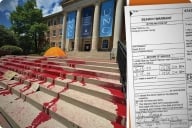You have /5 articles left.
Sign up for a free account or log in.
In early 2014 when I left Cornell, I submitted a book proposal with the university press for peer review. By the beginning of the next year I had a contract with a pretty short deadline of January 2016. I began writing it in earnest in Gaeta, Italy in June of 2015 and did not finish until a year later, missing the deadline and the passing of one editor at the press to another. Rather than go through the process again, I have decided to publish the manuscript online with UMass Amherst’s Library’s Scholarly Works.
Below is a reproduction of the conclusion. It offers a summary of the main topics of free speech, privacy, intellectual property, security, and reflections on the Apple iPhone case. Some of the chapters draw very directly on my experience as the Director of Information Technology Policy at Cornell University in the years from 2001-2014 accentuated by national issues such as the Oklahoma “racist chant” incident, the Salaita episode at the University of Illinois, Urbana-Champagne, the Robert Morris “worm,” and the meaning of Aaron Swartz’s life.
The entire manuscript can be found here. The format’s orientation is a little funky, but easy enough to follow either if you want to pick and choose particular chapters of interest to read or to follow the manuscript from introduction to conclusion by searching through the titles. As always, have at it! I am genuinely interested in your comments.
CONCLUSION
In Chapter One I argued that the Internet is having an ironic effect on free speech. Technology expands the access to and exponentially amplifies the reach of “free speech,” which results in the use of exceptions and conditions — especially in the higher education milieu — to exercise constraints, even under contemporary First Amendment jurisprudence. The University of Oklahoma and the Salaita affair at the University of Illinois, Urbana-Champaign, are cases in point.
In keeping with the complexity of the subject of privacy, Chapter Two took a dual approach. A consumer privacy approach demonstrated how higher education became a target for abuses at the hands of at least one significant internet company, Google and its Google Applications for Education (GAFE). The other approach, which combines government surveillance and information privacy issues, demonstrates how institutional policy reflects the significance of citizen privacy and information management/technology in supporting higher education’s missions.
Chapter Three studied technology’s effect on intellectual property. It depicted the content industry’s — the Recording Industry Association of America for the music industry, in particular — angered reaction to the internet’s effects on the mid-twentieth-century lock it had on technology, market, social norms, and law. Higher education became its whipping boy by virtue of its science and technology prowess, early-in-the-game robust broadband networks, and a demographic of consumers that relied on music (and other media) for social-psychological development. Among other lessons, this narrative demonstrates how easily money-rich industries with long lobbying ties to Congress can influence public opinion and the law, instrumentally using higher education once again, as in Google did with privacy, as a target. Moreover, as both producers and consumers of intellectual property, higher education acts as test tube and incubator for new intellectual property paths for society to contemplate.
Chapter Four examined legal and policy issues related to cybersecurity. Early in the game of cybersecurity efforts — including the seminal case of Robert Morris, Jr., and the “Computer Worm” — higher education, and Cornell University in particular, set the stage for what becomes by the 2010s front page news about identity theft; among the examples are Home Depot and Target, the New York Times, Blue Cross/Blue Shield, the Federal Government’s Office of Management and Budget and the State Department, the Democratic National Committee, and numerous other educational, governmental, and industry entities. I argue that higher education offers a unique opportunity to host an international discussion on issues of internet governance, which lie at the heart of the challenge that cybersecurity presents.
Chapter Five is an analysis of the San Bernardino iPhone case. Because it touches on free speech, privacy, and security in high-profile terrorism cases — and implicates the citizen-government-corporate roles and relationships in that context — a dispassionate meditation on the luxury and responsibility of higher education to facilitate such concerns acts as a conclusion to this manuscript.






